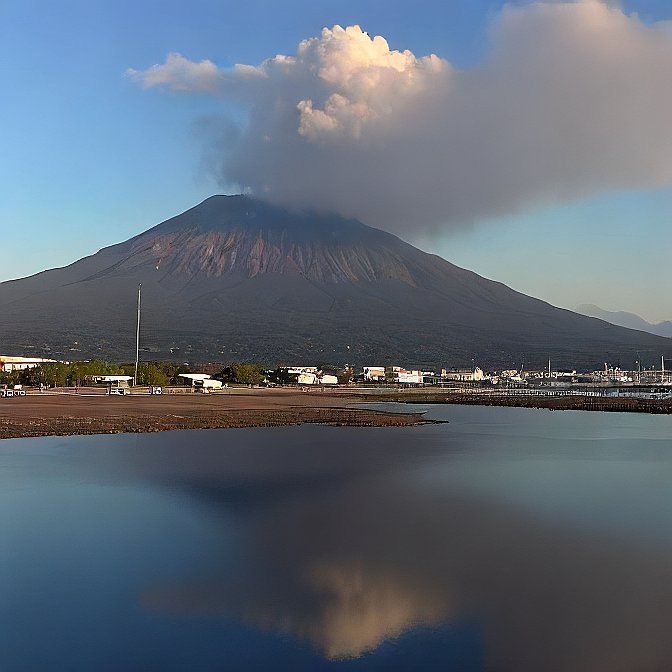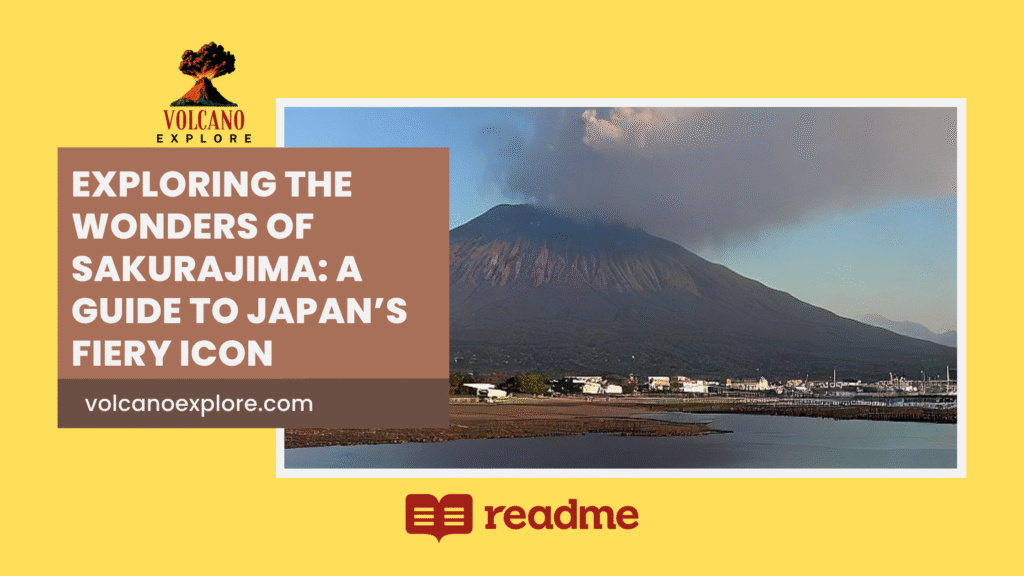Table of Contents
Introduction

People worldwide visit Sakurajima because this Japanese active volcano stands as a breathtaking island attraction for adventure seekers and nature enthusiasts. Sakurajima in Kagoshima Prefecture forms the southernmost point of Japan while the volcanic forces have continuously molded both the landscape and the cultural heritage of the region for centuries. Travelers who seek authentic exploration through rugged volcanic landscapes should experience Sakurajima because of its volcanic eruptions and local cultural richness. During your visit to Sakurajima you can engage in crater hiking and hot springs soaking with nice views or explore the geological marvels of the island which will leave your imagination spellbound.
What is Sakurajima?
Sakurajima exists as an island volcano that shows its primary aspects toward the Kagoshima urban center from its position in Kagoshima Bay. Sakurajima obtained its “Cherry Blossom Island” name because it historically operated as an island encircled by waters before its connection occurred through a slender piece of land. The geological wonders of this place draw attention to the island. Since ancient times Sakurajima has persisted as an active stratovolcano and it remains explosive during varied eruptive phases. Sakurajima experienced its most powerful eruption in 1914 when intense lava activities changed the surrounding terrain in a significant way.
The volcanic structure of Sakurajima includes three active craters namely Showa Crater and Minamidake and Kitadake which generate the intense volcanic visual effect. Perpetual volcanic operations guide how Sakurajima shapes regional economics and culture and controls the normal operations in the surrounding territory. Active volcanic ash features combined with fumaroles (gas vents) create unique conditions that attract researchers to analyze vegetation and fauna systems.
How to Get to Sakurajima
Visitors find it simple to reach Sakurajima from Kagoshima City because this location serves as the main urban center. The ferry service from Kagoshima Port to Sakurajima takes only 15 minutes which makes the destination simple to reach for those interested in visiting. During the ferry journey viewers can admire spectacular island and volcanic views since the boat approaches Sakurajima. Regular ferry services operate to Sakurajima without a passenger reservation system. Travelers can choose to board their car or bicycle on the ferry to have better mobility across the island.
An alternative transportation option to reach Sakurajima starts in Kagoshima and leads through the land. You can access Sakurajima through its mainland bridge connection while the island also has bus and taxi services. People who have access to personal vehicles can use rental cars to explore all attractions as well as scenic viewpoints freely.
Top Things to Do in Sakurajima

Hiking the Volcano
Visitors who enjoy climbing outdoors can make the volcanic crater trails of Sakurajima a must-do activity on the island. The Showa Crater, in particular, offers spectacular panoramic views of Kagoshima Bay and the surrounding areas. Different hiking routes of varying difficulty run across the island as trails extend from basic easy walks up to strenuous climbs. The path takes hikers across rough terrain where they can see volcanic rock shapes and fumaroles releasing steam and gases for a remarkable worldly atmosphere.
The hiking paths on the island are properly indicated by markers while informational posts describe the geological details of the area. The most adventurous hikers can choose paths that bring them near the crater areas where they can experience being near an active volcano. Safety takes precedence at these locations thus residents should consult with local authorities about current volcanic activity before setting off on hikes.
Sakurajima Visitor Center
All visitors must stop at the Sakurajima Visitor Center to gain comprehensive knowledge about the historic and geological aspects of the island. The exhibition space at the center presents displays about volcanic activity on the island together with geological understandings and human settlement records from its past. The site offers knowledge about volcanic activity on the island and shows how people living on the island work in the face of continual volcanic danger.
The starting point for island tourists should begin with this center because it gives essential maps and informs visitors about safety precautions and shows them which areas represent top attractions.
Kurokami Lava Field
The Kurokami Lava Field stands as a remarkable site that displays the results of past volcanic eruptions along the western side of Sakurajima. Black volcanic rock masses at the Kurokami Lava Field emerged through the lava flows that occurred during the 1914 volcanic event. The region contains irregular rocks and distinctive geological formations that give it an otherworldly ambiance. Geological experts together with photographic enthusiasts will find this location most suitable for observing dramatic scenery.
Exploring the lava field creates a sense of humility because people witness firsthand the extraordinary power that nature maintains and volcanic processes persist on the island.
Onsen (Hot Springs)
Every trekker needs a natural hot spring bath from Sakurajima to find proper relaxation after an active day of hiking. The thermal baths across the island provide relaxing hot baths which grant panoramic views of both Krakatoa volcano and the surrounding bay. Travelers can use both hotel-based and public bath options to access the onsens because their locations remain readily accessible.
The hot mineral-rich waters in Sakurajima become warmer thanks to volcanic activity that then provides healing properties to soothe muscles along with helping people relax. Guests will remember forever their time bathing in the onsen while looking at the volcano.
Sakurajima Lava Park
The Sakurajima Lava Park provides interactive displays to teach visitors about volcanic activity on the island through novel exhibits. Educational signage as well as statues and panels throughout the park provide historical insights about the island together with detailed information about its largest volcanic event from 1914. The site presents both informative content and aesthetic appeal to let visitors understand the volcanic environment next to engaging visual displays.
Curious for more? Dive into our other exciting blogs!
The Local Culture and Traditions of Sakurajima
The volcanic site of Sakurajima maintains both its geological appeal together with civic history. The island contains a lively native population which allows visitors to experience how the island residents lead their lives. The economy of Sakurajima relies heavily on agriculture because of its internationally renowned large delicious daikon radish production. Melon radish from Sakurajima becomes famous because of the volcanic earth it grows in while offering outstanding flavor together with exceptional features. Radishes from Sakurajima are commonly utilized to create traditional Japanese food products like pickles together with soups.
A significant aspect of Sakurajima features artisanal pottery along with its main agricultural sector. The local craftsmen create stunning ceramic works which serve as ideal souvenir items so visitors may bring back island memories through these ceramic pieces.
Festivals hold significant importance in local culture as people highly regard the Sakurajima Fire Festival among all events. Each year this festival showcases the volcanic history of the island through local traditional music performances together with dance and fire shows as spectators watch eruptions from the volcano.
Where to Stay on Sakurajima

The island of Sakurajima provides visitors with accommodation choices between classic Japanese ryokan inns and contemporary hotels to match different guest choices. The rooms of several lodging establishments provide spectacular volcano views that allow visitors to witness Sakurajima’s eruptions from their lodging space.
Traditional travelers will find ryokans as their best lodging option on their visit. Hotels on the island permit guests to learn about Japanese services while enjoying traditional tatami flooring and futons along with multi-course dining services known as kaiseki. Hot spring facilities in certain ryokan let their guests immerse in the natural waters following their sightseeing activities.
Visitors can choose from numerous hotels in Kagoshima which give Sakurajima views and simple ferry services enable them to visit the island for daily exploration.
Sakurajima’s Volcano: The Heart of the Island
Sakurajima functions as an active power source which remains the vital foundation of the island. The volcano serves as a permanent symbol of natural strength and demonstrates a continuous threat of volcanic activity. People who visit the island will be struck by the volcano’s grandeur as they simultaneously maintain safety awareness due to its hazardous characteristics. Sakurajima remains under constant surveillance and notifies visitors about imminent eruptive activity. Sukurajima residents maintain up-to-date information about volcanic activities while encouraging tourists to observe all safety parameters during their island exploration.
The volcano produces stunning eruptions which serve as fundamental elements for the natural system of the region. Active geothermal features generate energy that heats the hot springs whereas volcanic ash makes the soil more fertile hence supports agricultural development on the island.
Best Time to Visit Sakurajima
Your preferred experience while visiting Sakurajima will determine the most suitable season for your trip. During spring the island falls under a magical spell as cherry blossoms completely cover its surface against the backdrop of dark volcanic rocks. The hot summer months in Sakurajima create comfortable outdoor conditions yet they often arrive with excessive heat along with moisture. Autumn creates perfect visiting conditions because Sakurajima transforms into a spectacular sight with its landscapes turning golden.
The island presents a peaceful winter atmosphere because of its reduced number of travelers and its refreshing temperatures. The volcanic activity at Sakurajima tends to intensify during wintertime while certain parts of the island become inaccessible due to heavy snow conditions.
Conclusion
As a destination Sakurajima delivers a combination of exploration opportunities together with cultural heritage and breathtaking natural scenery. A visit to Sakurajima grants visitors extraordinary moments that produce enduring memories because the island allows both volcano hiking and crater observation from its baths. Travel seekers who want an extraordinary destination should include Sakurajima on their itinerary because it offers both cultural richness and geological fascination and breathtaking scenery.
For more info about volcanoes: Click Here.
FAQs
Is it safe to visit Sakurajima with the active volcano?
Sakurajima functions as an active volcano yet professional surveillance keeps it under watch and active protective systems operate. Tourists can obtain the latest volcanic activity data from local authorities while they must always follow all provided guidelines for safety.
What is the best way to explore Sakurajima?
Touring Sakurajima most effectively happens through trail hiking followed by stops at the Sakurajima Visitor Center and enjoying volcanic lava fields and hot springs. Renting a car enables visitors to navigate the island freely.
What is the local cuisine of Sakurajima?
Thanks to its celebrated Sakurajima daikon local farmers gain popularity from offering the potato vegetable for numerous culinary creations. The area’s traditional cuisine includes both local seafood specialties as well as tonkotsu ramen and black pork recipes.





